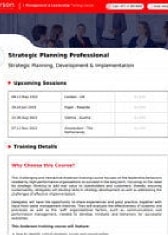
An Intensive 5-day Training Course
Strategic Key Account Management
How to Become the Preferred Supplier to your Key Account Customers
UPCOMING SESSIONS
| Date | Venue | Fee | |
|---|---|---|---|
| 30 Mar-03 Apr 2026 | Amsterdam - The Netherlands | $5,950 | RESERVE A SEAT |
| 08-12 Jun 2026 | London - UK | $5,950 | RESERVE A SEAT |
| 05-09 Oct 2026 | Dubai - UAE | $5,950 | RESERVE A SEAT |
Training Course Overview
What strategies can you use to win key accounts and become a preferred supplier?
For many B2B businesses, this is a major challenge that requires a strategic approach to build and maintain relationships at multiple levels within the customer’s organization. A successful strategy involves understanding the customer’s unique challenges and demonstrating your value as a strategic partner rather than just another vendor.
This Strategic Key Account Management training course provides you with practical methods and real-life examples from the course director’s experience to help you achieve preferred supplier status and succeed in the B2B landscape.
Training Course Objectives
By attending this Anderson training course, delegates will be able to:
- Design a key account strategy and apply it in practice
- Elevate the status of your organisation within the key account
- Construct value propositions that win preference with the right people
- Overcome the challenge of buyers who want you to lower your prices
- Influence the customer’s specification and negotiate from a stronger position
- Use your key account team more effectively
Designed for
This Anderson training course is suitable to a wide range of professionals but will greatly benefit:
- Global Heads of Key Accounts who want to secure Key Account customers globally
- Key Account Directors who want to become the Key Account customer’s preferred partner
- Key Account Managers who need to construct and implement a credible Key Account plan
- Key account team members who are required to contribute to the Key Account plan
- CEOs who want to increase margins and build stronger ties with their Key Accounts
- Other managers who are required to understand the Key Account plan and support it
The Course Outline
- The principles of effective key account management
- Understanding the five levels of KAM
- Information required to construct a key account strategy
- Structuring the key account strategy
- Putting your objectives and strategy into context
- Identifying the customer’s challenges and Key Success Factors
- Finding and filling their capability gaps
- Identifying hidden influencers in the key account
- Discovering their challenges and priorities
- Understanding their attitudes, perception and motivation
- Creating and using personas
- How to tackle competitors in the account
- Defining your KSFs for the account
- Explaining and justifying your strategy and objectives
- Targeting to influence the product specification
- Building relationships with key decision-makers
- Developing credibility outside the account
- Communicating inside the key account
- Becoming the thought-leader externally and internally
- Offering the customer superior value propositions
- Communicating to make your prices buyer-proof
- Using principled negotiation with the key account
- Templates and tools to construct the key account strategy
- Tools to manage and control the strategy
- Forming the key account team
- Using colleagues from different disciplines to add value in the key account
- Building and maintaining motivation for your key account strategy
The Certificate
- Anderson Certificate of Completion will be provided to delegates who attend and complete the course
In Association With



Learn More About
this course
How can I register for a training course?
There are several convenient ways to register for our training programs:
- Online: Explore our training calendar, choose the course that suits your needs, and click the “Register Now” button on the course details page.
- Email: Share your details, including your name, organization, email address, and selected course, by sending an email to [email protected]
- Phone: Reach out to us directly at +971 4 273 3503, and our team will guide you through the registration process.
When will I receive confirmation of my registration?
Once your registration is successfully completed, you will receive a confirmation email within 24 hours. This email will contain your registration details, invoice, and the necessary joining instructions for the course.
What does the training fee cover?
Where are your training courses held?
Our training programs are hosted at luxurious five-star hotels in prestigious destinations across the globe. Some of our popular locations include Dubai, London, Kuala Lumpur, Amsterdam, New York, Paris, Vienna, and many other iconic cities.
Can I request customized corporate training?
Yes, we offer tailored corporate training solutions to meet your organization’s specific needs. Please contact us at [email protected] or call +971 4 273 3503 for more information.
RELATED COURSES









